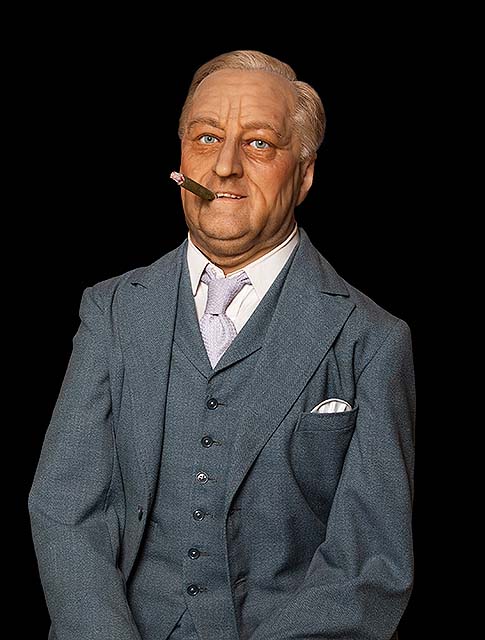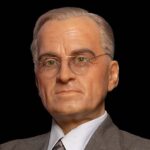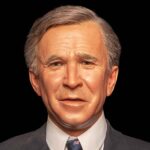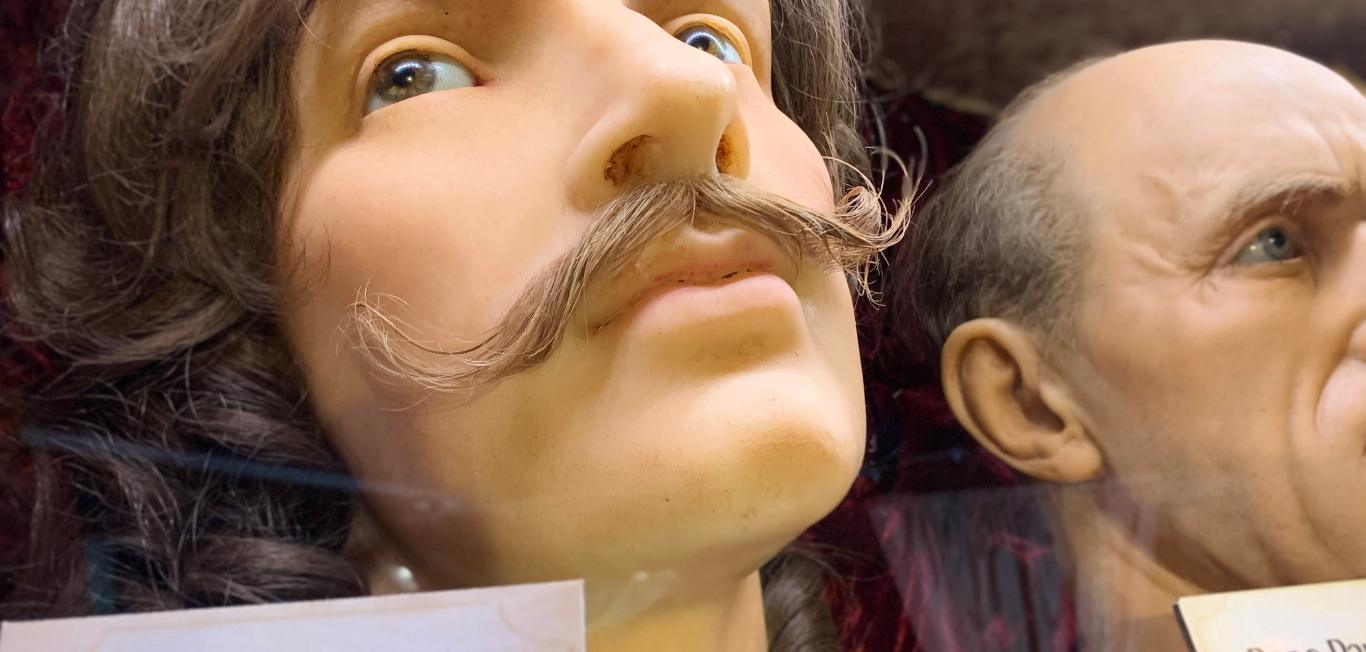Early Life
On January 30, 1882, the wealthy family of James Roosevelt and Sara Ann Delano, of English descent, welcomed their first and only child Franklin Delano Roosevelt. Little did the couple know the influence their child would have, as he would later go down in history.
Young Franklin D. Roosevelt, whose mother’s ancestry came from the Mayflower, enjoyed a wealthy upbringing in Hyde Park, New York. Up until the age of 14, Franklin D. Roosevelt was home-schooled. Later, he went on to attend Groton Preparatory School in Massachusetts. While attending school in Groton, Massachusetts, young FD Roosevelt learned Christian values and showed them through his civic engagement. He was led to be a gentleman, taking up the cause of the underprivileged.
When Franklin D. Roosevelt enrolled at Harvard University in 1900, he focused primarily on extracurricular activities and maintained a busy social life. He started pursuing Anna Eleanor, who was also a Roosevelt, and Franklin D.’s fifth cousin once removed. Anna Eleanor, the niece and goddaughter of Theodore Roosevelt, was the fifth cousin of Franklin D. Roosevelt.
According to academic records, Franklin D. Roosevelt was just an average student. He completed his education at Harvard, earning a BA in history in 1903. Franklin D. Roosevelt enrolled in Columbia Law School the next year. Despite not finishing his degree at Columbia, he passed the bar exam. After this, Franklin D. Roosevelt began his career practicing law. He began working on Wall Street at Carter Ledyard & Milburn’s firm, specializing in corporate law.
DID YOU KNOW
Anna Eleanor, the niece and goddaughter of Theodore Roosevelt, was the fifth cousin of Franklin D. Roosevelt.
Personal Life
Franklin D. Roosevelt was officially acquainted with his future spouse, Eleanor Roosevelt, in 1902 during a train journey to Tivoli, New York. Over time, they developed a strong rapport and understanding, culminating in their marriage in 1905. The couple was blessed with six children: Anna Eleanor; James; Franklin Delano, Jr.; Elliott; Franklin Delano, Jr.; and John Aspinwall.
However, their marital union evolved into more of a political partnership than an intimate relationship, with both Franklin and Eleanor navigating the complexities of their personal and public lives.
While Franklin D. Roosevelt and Eleanor Roosevelt did indeed share a strong political partnership, their personal lives were not without challenges. In 1921, Franklin contracted polio, which left him paralyzed from the waist down. This health crisis significantly impacted both his and Eleanor’s lives. Despite the physical limitations, Eleanor played a crucial role in supporting her husband’s political career.
Eleanor, known for her social activism and commitment to social justice, became an influential figure in her own right. She championed causes such as civil rights, women’s rights, and economic justice. This divergence in their individual interests and pursuits contributed to the evolution of their relationship into more of a political alliance rather than a traditional marital partnership.
Despite the challenges, Franklin and Eleanor’s marriage endured. They faced the Great Depression and World War II together, with Eleanor often representing Franklin in public appearances due to his health. The couple’s dynamic showcased a unique blend of shared political goals and individual pursuits, contributing to their legacy as one of the most influential couples in American political history.
DID YOU KNOW
In 1921, Franklin contracted polio, which left him paralyzed from the waist down. Eleanor played a crucial role in supporting her husband's political career.
Interesting Facts
Discovering the remarkable life of Franklin D. Roosevelt unveils a series of captivating facts that define his unique legacy. From his intricate family connections, including distant relations to his wife and 11 other U.S. presidents, to his privileged upbringing rooted in the Mayflower’s history, Roosevelt’s familial ties set the stage for an extraordinary journey. Despite a less-than-stellar academic record, his educational path led him from Groton, an elite Massachusetts boarding school, to Harvard College, where he courted his fifth cousin once removed Anna Eleanor Roosevelt. Post-Harvard, his pursuit of legal studies at Columbia Law School faced challenges, yet he passed the bar exam in 1907, marking the beginning of an unconventional career that transitioned from a prestigious Wall Street firm to the world of politics.
Roosevelt’s political prowess reached its zenith with unprecedented success in presidential elections. His victories in 1932, 1936, 1940 and 1944 formed the “New Deal coalition,” uniting diverse groups and showcasing overwhelming electoral and popular vote tallies. Breaking with tradition, FDR’s four-term presidency, spanning over 12 years, left an indelible mark on U.S. history and prompted the eventual ratification of the 22nd Amendment.
A captivating facet of Roosevelt’s life was his concealed handicap. Paralyzed from the waist down due to polio in 1921, he adeptly hid the extent of his disability, presenting an image of mobility through carefully orchestrated public appearances. The New Deal initiatives, implemented in two phases, transformed the nation, stabilizing the financial sector, ending Prohibition, and initiating public works projects. The “Second New Deal” introduced liberal measures, including increased taxes on the wealthy, guaranteed labor union rights, and the establishment of Social Security.
The drama of court-packing unfolded in 1937 as Roosevelt, frustrated with Supreme Court rejections, proposed a controversial plan to expand the Court. While the plan failed, it led to the Court ceasing to invalidate New Deal legislation. A darker chapter in FDR’s legacy involves the Japanese-American internment during World War II, where about 120,000 individuals faced forced relocation and imprisonment.
Amid these complexities, Roosevelt achieved an aviation milestone in 1932 by becoming the first sitting president to fly in an airplane, a testament to his dynamic and multifaceted legacy in American history.
DID YOU KNOW
Roosevelt's political prowess reached its zenith with unprecedented success in presidential elections with victories in 1932, 1936, 1940 and 1944.
Influence in History
In the 1912 presidential elections, Franklin D. Roosevelt lent his support to Woodrow Wilson’s candidacy. Wilson’s subsequent presidency opened new avenues for Roosevelt, leading to his transition from the New York State Senate to the role of Assistant U.S. Secretary of the Navy in 1913.
During his seven-year tenure at the Navy, Roosevelt immersed himself passionately in the intricacies of the position. He wholeheartedly supported Josephus Daniels, the Secretary of the Navy, in the endeavor to build a formidable and efficient naval force. Roosevelt played a pivotal role in expanding the Navy, securing budgetary approvals and ensuring its seamless functioning.
In a subsequent bid for the U.S. Senate seat of New York, Roosevelt faced challenges due to a lack of White House support, resulting in an unfavorable electoral outcome. This experience, however, served as a realization for Roosevelt about the formidable influence of White House backing.
During the early 1920s, Roosevelt actively worked on repairing his relationships within the Democratic Party. He threw his support behind Alfred E. Smith’s candidacy for the governor of New York in both 1922 and 1924.
In 1928, Roosevelt stepped into the position himself, succeeding Smith as the governor of New York in a narrow victory. His tenure as governor was marked by progressive reforms and the implementation of various social programs aimed at the betterment of society at large. Roosevelt’s success led to his re-election for a second term in 1930, solidifying his impact on the state’s governance.
Presidencies
First Term, 1933
Upon assuming office on March 4, 1933, Franklin D. Roosevelt confronted the United States in the throes of its most severe crisis. Unemployment rates had skyrocketed, reaching unprecedented levels, farmers grappled with a tragic 60% decline in prices, industrial production hit rock bottom, and hundreds of banks faced imminent closure.
True to his campaign promises, Roosevelt embarked on a multifaceted approach aimed at providing relief, recovery and reform to a nation in distress. Relief efforts focused on reinvigorating the vast unemployed workforce, while recovery initiatives sought to restore the economy to a state of normalcy. Simultaneously, Roosevelt implemented reforms aimed at permanently rectifying the financial and banking systems of the country.
In 1934, Roosevelt ushered in a transformative phase known as the Second New Deal. Central to this initiative was the establishment of the Works Progress Administration, a monumental effort that created a national relief agency employing approximately two million people. This bold step resulted in a nearly 8% reduction in the unemployment rate, offering a ray of hope during challenging times.
The momentum continued into the 1936 presidential election, where Roosevelt achieved a resounding victory by securing the majority of votes. This success was attributed to a diverse coalition of supporters, including traditional Democrats, small farmers, Catholics, urban political machines, labor unions, northern African Americans, Jewish people, intellectuals, and political liberals. The electoral triumph underscored the effectiveness of Roosevelt’s policies in garnering broad-based support across various demographic and ideological spectrums.
DID YOU KNOW
True to his campaign promises, Roosevelt embarked on a multifaceted approach aimed at providing relief, recovery and reform to a nation in distress. Relief efforts focused on reinvigorating the vast unemployed workforce, while recovery initiatives sought to restore the economy to a state of normalcy
Second Term, 1937
In stark contrast to the transformative reforms of his first term, Franklin D. Roosevelt’s second term experienced a notable decrease in the passage of major legislative initiatives. Notable among these were the Housing Act of 1937, a second Agricultural Adjustment Act, and the Fair Labor Standards Act of 1938, marking incremental steps amid a shifting political landscape.
Facing resistance, Roosevelt encountered a formidable challenge from the Supreme Court, which overturned several of his proposed reforms. Expressing frustration, he responded with a controversial proposal that would grant him the authority to appoint judges. However, this initiative faced widespread opposition, including dissent from Democrats, as it was perceived as granting the president excessive control over the judiciary.
The latter part of Roosevelt’s second term saw a decline in his legislative influence due to negative publicity, a persistently sluggish economy and setbacks in midterm elections favoring Republicans. The disintegration of support from labor unions, once steadfast allies, further weakened the Democratic Party in elections from 1938 to 1946.
In 1939, departing from the neutrality policy, Roosevelt pivoted toward supporting Britain and France militarily. Responding to the changing sentiments surrounding isolationism and the escalating conflicts in Western Europe, he bolstered military spending to enhance national defense capabilities.
As geopolitical dynamics shifted with the outbreak of conflicts in Asia and Europe, Roosevelt openly defied the Neutrality Act. He actively sought ways to assist China in its war against Japan and declared France and Great Britain America’s “first line of defense” against Nazi Germany. This marked a significant departure from previous policies, as the United States began providing military supplies to China, Britain and the Soviet Union.
Campaigning against Republican candidate Wendell Willkie in 1940, Roosevelt pledged to keep the United States out of war, emphasizing his commitment to peace. The electoral outcome reflected public confidence in his leadership, securing a resounding victory with 55% of the votes in all but 10 states. Henry A. Wallace assumed the role of vice president during this historic election.
DID YOU KNOW
Roosevelt encountered a formidable challenge from the Supreme Court, which overturned several of his proposed reforms. Expressing frustration, he responded with a controversial proposal that would grant him the authority to appoint judges.
Third Term, 1941
During much of Franklin D. Roosevelt’s third term as president, the global stage was dominated by the tumultuous events of the Second World War. Focused on supporting Allies like Britain, France and Russia, the United States, under Roosevelt’s leadership, transformed into the heralded “arsenal of democracy.”
Despite initial isolationist sentiments, Roosevelt faced some resistance from Senators William Borah and Robert Taft. Capitalizing on the evolving geopolitical landscape, he bolstered support for the Allies against Germany, Japan and Italy by significantly increasing the provision of essential supplies.
In collaboration with British Prime Minister Winston Churchill in 1941, Roosevelt devised a comprehensive program detailing the manpower, mobilization, industry, and logistics required to effectively counter the perceived threats to the United States.
The turning point for the United States’ active involvement in World War II occurred on December 7, 1941, with the unforeseen Japanese attack on Pearl Harbor. Despite anticipation of an impending conflict, the scale and intensity of the attack, resulting in extensive damage and the loss of 2,400 American military personnel and civilians, unequivocally propelled the nation into war.
In response to Germany and Italy declaring war on the United States, Roosevelt, in collaboration with military advisors, formulated a strategic approach. Objectives included halting German advances in the Soviet Union and North Africa, launching a Western European invasion to sandwich Nazi Germany between two fronts and safeguarding China while defeating Japan.
Driven by a resolute determination to defeat Japan, American forces were dispatched to the Pacific in 1942, achieving a pivotal victory in the Battle of Midway. Subsequently, a strategic island-hopping campaign was initiated, aiming to secure bases for strategic air power to pave the way for the eventual invasion of Japan.
Simultaneously, Roosevelt devised a comprehensive strategy for overcoming Germany in Europe, commencing with invasions in North Africa (November 1942), followed by Sicily and Italy in 1943, culminating in the monumental D-Day invasion of Europe in 1944.
World War II
The turning point for the United States' active involvement in World War II occurred on December 7, 1941, with the unforeseen Japanese attack on Pearl Harbor.
As the Allies gained momentum against Nazi Germany by 1943, Roosevelt took visionary steps. He convened a crucial meeting with Churchill and Chinese leader Chiang Kai-shek to discuss the postwar future of Europe. It was during this historic gathering that Roosevelt laid the foundation for the establishment of the United Nations, showcasing his commitment to a collaborative international order in the aftermath of a world-altering conflict.
Fourth Term and Final Years
Franklin D. Roosevelt’s historical significance in U.S. history is unparalleled, as he remains the only president to be elected to office four times, a record unbroken to this day. His fourth-term victory in the 1944 elections was strategically secured by choosing Harry S. Truman as his running mate for the vice presidential position. This pairing resulted in an impressive 53% of the popular vote and carried 36 states, solidifying Roosevelt’s unprecedented tenure in office.
In the closing days of his presidency, Roosevelt embarked on a crucial diplomatic journey to Egypt to participate in the Yalta Conference. During this historic event, he engaged in significant meetings with notable figures such as Haile Selassie, the Emperor of Ethiopia, and King Abdulaziz, the founder of Saudi Arabia. Following the Yalta Conference, Roosevelt diligently briefed Congress on the proceedings, marking a notable chapter in his foreign policy legacy.
Tragically, Roosevelt’s last international engagement marked the culmination of his storied political career. Shortly after returning from the Yalta Conference, his declining health became evident. Despite being elected for an unprecedented fourth term, Roosevelt’s illness, characterized by multiple health issues including high blood pressure, atherosclerosis, coronary artery disease leading to angina pectoris, and congestive heart failure, ultimately claimed his life on April 12, 1945. The toll of these health challenges marked the end of an era, leaving behind a legacy of both political accomplishments and personal struggles.
FAQs
Why is Franklin D. Roosevelt famous?
Franklin D. Roosevelt is renowned for his leadership during two critical periods in U.S. history. First, as the 32nd president from 1933 to 1945, he implemented the New Deal to address the Great Depression, introducing programs including Social Security and the Works Progress Administration. Second, FDR served as a pivotal leader during World War II, guiding the nation through the conflict. His legacy includes being the only president elected to four terms and playing a key role in establishing the United Nations.
How long did Franklin Roosevelt serve as president?
Franklin D. Roosevelt served as president for four terms, from March 4, 1933, to April 12, 1945.
What did President Franklin D. Roosevelt do in his first term as president?
In his first term as president (1933-1937), FDR focused on addressing the immediate economic challenges of the Great Depression. He implemented the New Deal, a series of programs and reforms designed to provide relief, stimulate economic recovery, and reform the financial system. Key initiatives included the Civilian Conservation Corps, the Public Works Administration, and the Social Security Act.
Who is the longest-serving U.S. president?
Franklin D. Roosevelt holds the record for being the longest-serving president of the United States. He served four terms from March 4, 1933, to April 12, 1945. However, the 22nd Amendment to the U.S. Constitution, ratified in 1951, limits presidents to two terms, so no president can serve more than eight years in office today.
Who was Franklin D. Roosevelt’s vice president during his fourth term?
Harry S. Truman was Franklin D. Roosevelt’s vice president during his fourth term. Truman later became the 33rd president of the United States after Roosevelt’s death.










